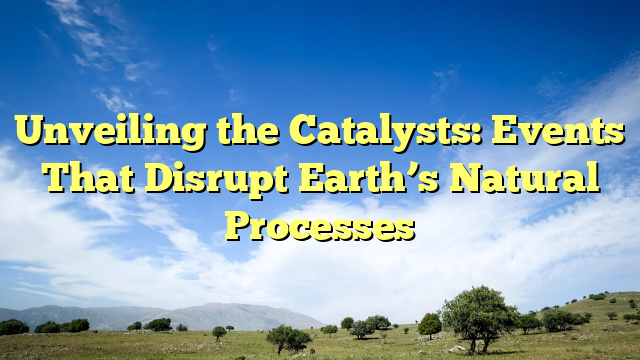Unveiling the Catalysts: Events That Disrupt Earth’s Natural Processes
Unveiling the Catalysts: Events That Disrupt Earth’s Natural Processes
Earth’s natural processes are finely tuned systems that have developed over millions of years. These processes, including the water cycle, carbon cycle, and nitrogen cycle, among others, are essential for maintaining the planet’s delicate balance. However, certain events can disrupt these processes, leading to significant environmental impacts. This article explores the catalysts behind these disruptions, shedding light on their causes, effects, and the broader implications for our planet.
Understanding Earth’s Natural Processes
Before delving into the disruptors, it’s crucial to understand the natural processes that sustain life on Earth. These include:
- The Water Cycle: This cycle describes how water evaporates from surfaces, condenses in the atmosphere, and returns to the surface via precipitation.
- The Carbon Cycle: This cycle illustrates how carbon dioxide is absorbed by plants for photosynthesis, released into the atmosphere through respiration, and stored in oceans and the earth’s crust.
- The Nitrogen Cycle: This cycle shows how nitrogen is converted into various chemical forms as it circulates among the atmosphere, terrestrial ecosystems, and marine ecosystems.
Major Events Disrupting Natural Processes
Several major events can disrupt these natural cycles, including:
1. Volcanic Eruptions
Volcanic eruptions can have a profound impact on Earth’s atmosphere and its natural processes. They release large amounts of ash and gases, such as sulfur dioxide, which can alter climate patterns and affect the water cycle.
2. Deforestation
Deforestation disrupts the carbon cycle by reducing the number of trees available to absorb carbon dioxide. This leads to higher concentrations of CO2 in the atmosphere, contributing to global warming and climate change.
3. Industrial Pollution
Industrial activities release a variety of pollutants into the environment, including greenhouse gases, which affect the carbon and nitrogen cycles. These pollutants can also lead to acid rain, which has a detrimental effect on ecosystems.
4. Ocean Acidification
The absorption of excess carbon dioxide by the world’s oceans is leading to ocean acidification, disrupting marine life and the carbon cycle. This affects coral reefs, shellfish, and the species that rely on them for survival.
Effects of Disruptions on the Environment
The disruption of Earth’s natural processes has far-reaching effects on the environment, including:
- Climate Change: One of the most significant impacts is the alteration of global climate patterns, leading to extreme weather events, rising sea levels, and changing ecosystems.
- Loss of Biodiversity: Disruptions can lead to habitat loss and the extinction of species, reducing biodiversity and affecting ecosystem services.
- Water Scarcity: Changes in the water cycle can lead to droughts and water shortages, affecting agriculture, drinking water supplies, and natural habitats.
Addressing the Challenges
To mitigate the effects of these disruptions, several strategies can be employed:
- Reducing Carbon Emissions: Limiting the release of greenhouse gases through renewable energy sources and energy efficiency can help stabilize the carbon cycle.
- Reforestation: Planting trees and restoring forests can absorb CO2, enhance biodiversity, and restore the natural balance.
- Protecting Marine Ecosystems: Reducing pollution and overfishing, and establishing marine protected areas can help preserve ocean health and its natural processes.
Conclusion
The disruption of Earth’s natural processes by human activity and natural events poses a significant threat to the planet’s health and its inhabitants. Understanding these disruptions and their impacts is crucial for developing effective strategies to mitigate their effects and protect our planet for future generations. By taking collective action, we can work towards restoring Earth’s delicate balance and ensuring the sustainability of its natural processes.
| Disruption | Primary Effect | Secondary Effects |
|---|---|---|
| Volcanic Eruptions | Climate Alteration | Impacts on water cycle, temperature changes |
| Deforestation | Increased CO2 Levels | Global warming, loss of biodiversity |
| Industrial Pollution | Emission of Pollutants | Acid rain, health impacts, ecosystem disruption |
| Ocean Acidification | Disruption of Marine Life | Impact on coral reefs, shellfish populations |

